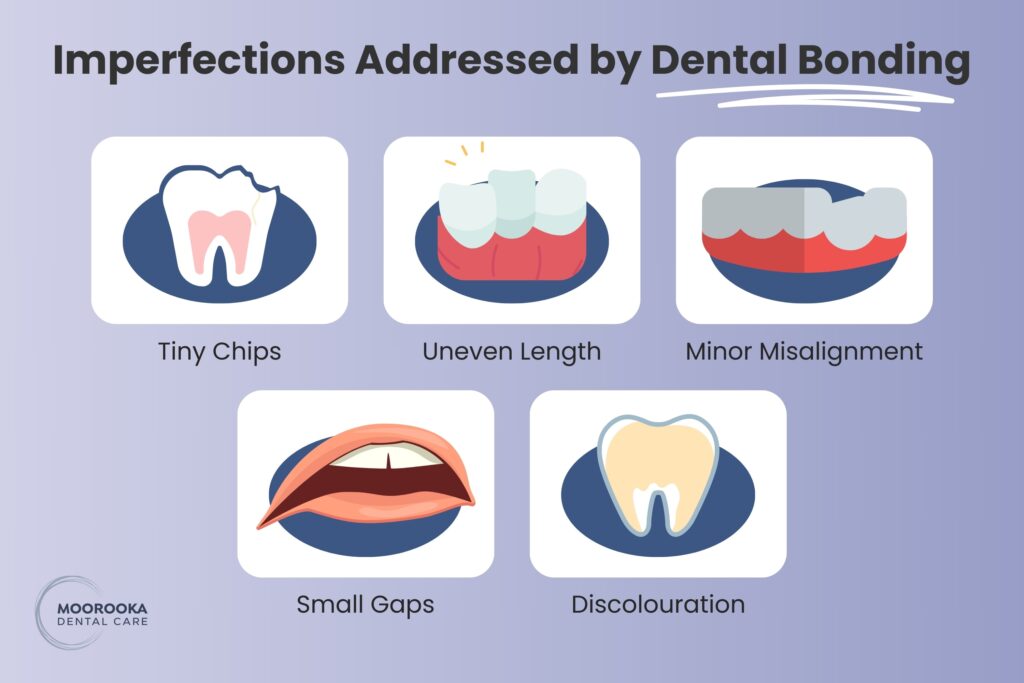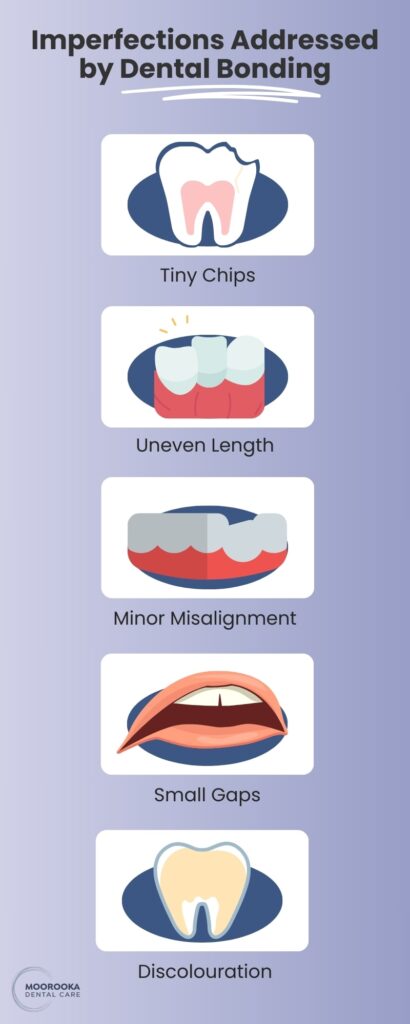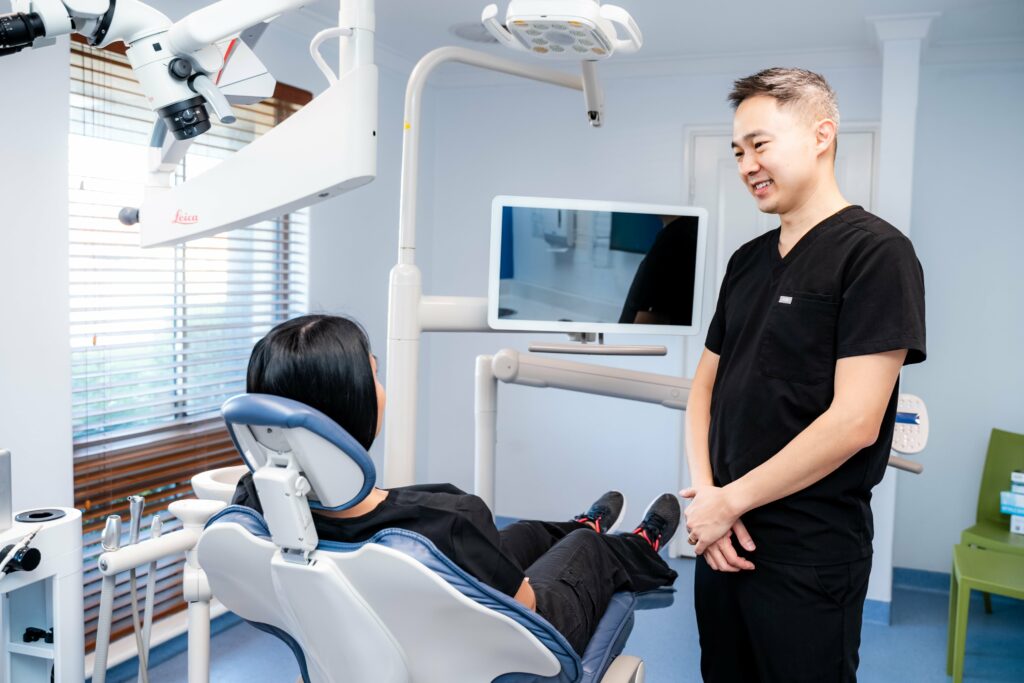Composite bonding is a dental procedure that uses tooth-coloured material to address minor imperfections in your teeth. So, if you’re worried about cracks, chips, or gaps, composite bonding may be the best way to brighten your smile.
What is Dental Composite Bonding?
This quick and effective procedure uses a tooth-coloured composite resin, similar to moldable plastic, which can be used to brighten your smile and in doing so, boost your self-confidence. Our dentists skilfully shape and harden the resin to restore both the look and function of your teeth, leaving you with a natural-looking smile.




Imperfections Addressed by Dental Bonding
- Tiny Chips: If you’ve ever accidentally chipped a tooth, dental bonding can replace the missing piece with a tooth-coloured resin, restoring both function and appearance.
- Uneven Length: Do you feel a tooth is slightly shorter than its neighbours? Bonding can lengthen the tooth to match the surrounding ones, creating a more balanced smile.
- Minor Misalignment: For mild misalignment, bonding can subtly add material to the teeth, bringing them into better alignment and enhancing your smile’s symmetry.
- Small Gaps: Gaps between teeth can be filled with bonding material, closing the space and creating a more uniform appearance.
- Discolouration: If teeth whitening isn’t an option for stubborn discolouration, bonding can cover the affected area with a natural-looking resin.
What Is the Dental Composite Bonding Procedure?
Composite dental bonding or teeth bonding is a quick and relatively painless procedure that can address various minor imperfections in your teeth. Here’s what you can expect:
Step 1: Consultation and Shade Selection
Your dentist will discuss your goals and examine your teeth to determine if bonding is suitable. They will then use a shade guide to find the perfect resin colour that seamlessly blends with your natural teeth.
Step 2: Tooth Preparation
To ensure optimal bonding, your dentist will gently roughen the tooth surface and apply a conditioning liquid. This creates a microscopic “grip” for the resin material.
Step 3: Resin Application and Shaping
The dentist carefully applies the resin to the affected area. They will meticulously sculpt the material to match the desired shape and size to ensure a natural and seamless look.
Step 4: Curing and Finishing
A special light is used to harden the resin, solidifying it in place. Once treated, your dentist will refine the shape, polish the surface, and make sure you have a comfortable and natural bite.
The entire process typically takes 30 to 60 minutes for a single tooth. Depending on the complexity and the number of teeth involved, multiple appointments may be necessary.




Advantages of Composite Bonding Treatment
Composite bonding works as an adhesive type of dentistry. It is considered cosmetic, but it may also provide additional benefits.
- Natural-looking results: The resin used in the procedure closely mimics the appearance of your natural teeth, blending seamlessly for virtually undetectable repairs.
- Minimal invasiveness: In contrast to procedures like crowns, bonding usually requires minimal removal of tooth structure, which preserves your natural tooth enamel.
- Versatility: Bonding can address a variety of concerns, including chips, cracks, gaps, misalignment, and even mild discolouration.
- Time-efficient: The procedure can typically be completed in a single visit, so it’s a convenient option for busy schedules.
- Cost-effective: Compared to other cosmetic dental options, bonding is typically a more affordable solution for achieving a brighter smile.
What are the Disadvantages of Composite Bonding?
While effective, composite bonding has some drawbacks:
- Durability: Compared to porcelain veneers (lasting 10–15 years), bonding may need to be replaced every 5–7 years due to potential chipping or wear.
- Staining: Unlike veneers, composite bonding resin is more prone to staining from coffee, tea, cigarettes, etc., so it requires careful maintenance.
- Appearance: While improved, bonding may not perfectly match your surrounding teeth, especially with extensive colour changes.




What are the Alternatives to Dental Bonding?
Dental bonding is a great option for minor cosmetic concerns, but there are alternative solutions, depending on the severity of the issue. You can choose to get dental veneers instead. Veneers are thin, custom-made shells that are bonded to the front surface of your teeth with special dental adhesive. They are more durable and stain-resistant than dental bonding, and can last for 5–7 years (composite) or 10–15 years (porcelain) with proper care. Veneers are a good option for teeth that are chipped, cracked, discoloured, misaligned, or unevenly spaced.
You could also think about getting dental crowns. Crowns are caps that are placed over the entire tooth, restoring its strength, size, shape, and appearance. They are the most durable option and can last for up to 15 years with proper care. You’ll need crowns if your teeth are severely damaged, decayed, or have large fillings.
If your only concern is discolouration, teeth whitening may be a more affordable option. However, it is not effective for all types of staining and may not be suitable for everyone. Remember to discuss all your options for cosmetic dentistry with your dentist.
What’s the Difference between Veneers and Dental Bonding?
Veneers are like custom-made shells for your teeth. They are very durable but take longer, while dental bonding is a faster, one-visit fix with resin but can stain and chip more easily.
Choosing between dental bonding and veneers can be confusing. Both can help you get a better smile, but they differ in material, durability, and cost. Here’s a quick comparison to help you decide:
| Feature | Dental Bonding | Veneers |
| Material | Tooth-coloured resin | Thin shells of porcelain or resin |
| Durability | 3–7 years | 10–20 years |
| Procedure | Less invasive; usually 1 visit | Requires enamel removal; 2–3 visits |
| Appearance | Can stain; may not match perfectly | Highly resistant to staining; excellent aesthetics |
| Cost | More affordable | More expensive |



How Much Is Composite Bonding?
Dental bonding will cost you between $300 and $600 per tooth. On the other hand, veneers will set you back $1,500 and up per tooth (porcelain veneers) or $500 and up per tooth (composite veneers). Dental bonding is significantly cheaper than veneers.
While bonding is more affordable upfront, it might not be the most cost-effective option in the long run. Composite bonding has a shorter lifespan, and your bonded teeth may need repairs or replacements.
The cost of dental bonding in Australia typically ranges from $300 to $600 per tooth. It’s important to note that this is an estimate, and the actual cost can vary depending on several factors. To get an accurate price for your specific needs, please contact Moorooka Dental Care for a consultation. Our friendly team will discuss all of your options to determine the best solution for your budget and dental needs.
Preferred Health Fund
Providers with:







The Dental Team
Meet these highly skilled and experienced professionals with expertise in cosmetic dentistry, restorative dentistry, and dental implant treatment.

Composite Bonding for Teeth FAQs
How long does composite bonding last?
While composite bonding can last for 3–7 years with proper care, this can vary depending on factors like the location of the bond and eating habits. You might notice slight wear and tear after 5 years, but this is usually nothing to worry about. With proper care and daily brushing, your bonded teeth can stay strong and beautiful, and function well for many years to come.
Is composite bonding covered by insurance?
In some cases, your insurance may cover composite bonding if you need it because your tooth is decayed or cracked. Most insurance will not cover dental bonding for cosmetic purposes.
Is dental bonding painful?
No, dental bonding is generally a painless procedure because the dentist avoids the sensitive nerve inside your teeth. Anaesthesia is often not required. However, some people might experience temporary sensitivity following the procedure.
Visit Moorooka Dental Care for Comprehensive Dental Treatments
Shop C, 132 Beaudesert Road,
Moorooka QLD 4105
Tel: (07) 3848 3193
Public Transport:
Moorooka Dental Care is the local preferred dental practice for many suburbs in Brisbane as well as the Brisbane CBD. Our team of exceptionally skilled and experienced dentists will go above and beyond to give you the smile you’ve always wanted. We’ll also make sure that you’re as comfortable as possible throughout your visit.
We hope to see you soon!



“Composite Bonding Brisbane | Cost and Options”
The care and treatment I received from Moorooka Dental was Five Stars all the way. I felt supported and everything about my procedure was spoken with a caring and kind demeanour. I felt safe and comfortable throughout. From the moment I walked in to even being wheel chaired back to my car for my drive home was second to none. Thank you so very much Team Moorooka Dental. Highly recommend ????
“Composite Bonding Brisbane | Cost and Options”
I had my wisdom teeth removed here, Dr Zaheer was very professional and informed me everything I needed to know about the procedure. All the staff are extremely friendly and informative. Highly recommend to anyone who needs any dental work.
“Composite Bonding Brisbane | Cost and Options”
The dentist was outstanding. She was so gentle I felt almost no pain after the initial local was administered. Probably the best dentist I have been to. She was also very fair about pricing and substantially cheaper than the dentist I had previously seen in the CBD. Outstanding service.
“Composite Bonding Brisbane | Cost and Options”
The team at Moorooka Dental Care are amazing!!! From the dentists and dental assistants to the reception staff go above and beyond. They have made going to the dentist such a pleasant experience. I had to have major work done including implants, they made the whole process so easy. Drs Sunny and Kadwa are super lovely and their international training and experience are the best!!! Don’t go anywhere else…..
“Composite Bonding Brisbane | Cost and Options”
I have not been to the dentist in years and only went today as it was an emergency. I went to Moorooka Dental Care because a few people had recommended it. All I have to say is that for someone that gets very anxious, I was put at ease even before I sat in the chair. It started from the Receptionist, Fatimata, to Ahmed (owner), to Dentist (Reza), to his dental assistant (Raeesa). They were all so amazing and Reza was so gentle and caring and explained every step. I was very comfortable. I will definately be going back, will take my son there from now on and tell all my family and friends about this place. Customer service is top notch! Thank you to all of you I met and those im yet to meet.